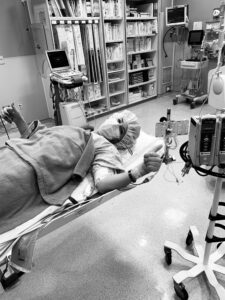Ten years ago, Tracy Kyttle moved from New England to the DC Metro Area to pursue a career in education leadership. She loved the area’s duality: its proximity to nature and far-reaching cityscape, its quiet areas of reflection and diverse and vibrant culture. Her time in the DC Metro Area has helped her to pursue her passions, like volunteering in the NICU at Children’s National Hospital. And perhaps most importantly, Tracy found her own freedom here after her systemic mastocytosis diagnosis.

Over the last five years, Tracy underwent several health issues that eventually culminated in her diagnosis. Her proximity to the NIH allowed her to become involved in numerous forms of research. As such, Tracy has helped advance a scientific understanding of mastocytosis —and how it fundamentally impacts those affected.
Recently, Tracy spoke with Patient Worthy about her own diagnostic journey with systemic mastocytosis, her participation in research at the NIH and NIAID, and how she has documented her experience at Daretoberare.me.
Tracy’s Story
It all began with a hot tub.
The diagnostic journey, that is.
In 2018, Tracy and her friend got together over Labor Day weekend, intent on soaking up the last bit of summer in the hot tub of Tracy’s apartment community. They were deep in conversation when Tracy’s legs began to tingle. She itched and scratched, but the burning sensation spread from the outer surfaces of her thighs to the sides of her knees, down to the backs of her calves and top of her feet:
“My body felt like a million mosquitos were feasting on my flesh. I tried to distract myself from the distress by indulging my friend in dialogue about her budding entrepreneurial venture and her latest visit home to Nepal. Despite my efforts, nothing stopped the rage of discomfort manifesting underwater. The urge to itch and scratch every centimeter of my extremities became so profound that I pulled myself out of the tub, only to be met with the sight of large hives covering what I once recognized as my lower body. I dug my fingers into my skin, making every effort to alleviate the invasion of pain. The hives multiplied, transformed into flat red spots, and eventually dissipated.”
Over the next two years, Tracy experienced increasingly frequent and worsening episodes of hives. She began having blistering skin reactions on a monthly cadence, particularly following a warm shower. Her symptoms seemed to be cyclical: first the itching, then the hives, and finally the transcendence of red patches before it resolved altogether in about thirty minutes.
At first, Tracy tried to resolve her pain and itchiness with topical lotions. But she soon found that this worsened the hives, making the itchiness almost too intense to bear. She blamed the reaction on some sort of fragrance in her lotion or detergent, or even shampoo and conditioner, that was causing a reaction. An allergy to water? It never crossed her mind.
Searching for a Diagnosis
At the start of 2020, Tracy’s condition worsened. Every day, she would experience outbreaks of hives from head to toe. These outbreaks occurred multiple times each day for thirty to forty minutes at a time. It was debilitating and discouraging for Tracy. Eventually, she decided it was time to visit a dermatologist who provided her with a steroid cream. Tracy shares:
“After two weeks of rubbing sticky ointment on every inch of my legs, the rash remained unchanged. At that point, my nurse practitioner proposed an emergency skin punch biopsy and a request for labs to rule out mastocytosis. Four days later, the world shut down from the COVID-19 pandemic.”
After seven weeks of waiting for a follow-up appointment, Tracy was referred to the Washington Cancer Institute for a specialized consult in April, as doctors believed that she did have mastocytosis. The Washington Cancer Institute then submitted a second referral to the NIH. Twelve hours before her first bone marrow biopsy, the NIH got in touch to let Tracy know that they would take her case. However, the diagnostic journey could not continue until the NIH could reopen to take on patients enrolling in clinical trials. As a result, Tracy’s diagnostic journey took around seven months to finish.

At points, she shares, this was frightening:
“I waited in limbo for someone to tell me if I had six months to live or sixteen years.”
However, learning of mastocytosis, Tracy decided to dive into research. She found every published research paper, pored through the details, and analyzed the limited case studies. Whenever she had spare time, she was online, strengthening her scientific understanding and trying to predict her eventual prognosis. She felt like answers were improbable.
Then, finally, she was admitted to the NIH. She says:
“The National Institute of Allergy and Infectious Diseases (NIAID) changed my life, and I will be forever indebted to my team and the community that gave me answers that nobody else in the world seemed able to provide.”
Join us in Part 2 and Part 3 to discuss what mastocytosis is, Tracy’s time with the NIH, disease management, her blog experience (and book draft!), and advice to others facing a rare disease journey.






